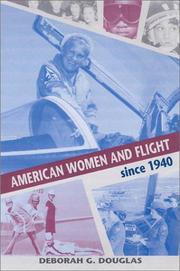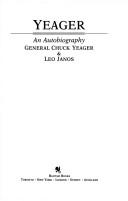| Listing 1 - 10 of 685 | << page >> |
Sort by
|
Book
Year: 1935 Publisher: London : Isaac Pitman & Sons,
Abstract | Keywords | Export | Availability | Bookmark
 Loading...
Loading...Choose an application
- Reference Manager
- EndNote
- RefWorks (Direct export to RefWorks)
Book
ISBN: 9782343133379 2343133379 Year: 2018 Publisher: Paris : l'Harmattan,
Abstract | Keywords | Export | Availability | Bookmark
 Loading...
Loading...Choose an application
- Reference Manager
- EndNote
- RefWorks (Direct export to RefWorks)
Book
ISBN: 9781612004822 Year: 2017 Publisher: Oxford Philadelphia Casemate
Abstract | Keywords | Export | Availability | Bookmark
 Loading...
Loading...Choose an application
- Reference Manager
- EndNote
- RefWorks (Direct export to RefWorks)
The Casemate Short History Series presents readable and entertaining introductions to military history topics. Just over a decade after the first successful powered flight, fearless pioneers were flying over the battlefields of France in flimsy biplanes. As more aircraft took to the skies, their pilots began to develop tactics to take down enemy aviators. Though the infantry in their muddy trenches might see aerial combat as glorious and chivalric, the reality for these ‘Knights of the Sky’ was very different and undeniably deadly: new Royal Flying Corps subalterns in 1917 had a life expectancy of 11 days. In 1915 the term ‘ace’ was coined to denote a pilot adept at downing enemy aircraft, and top aces like the Red Baron, René Fonck and Billy Bishop became household names. The idea of the ace continued after the 1918 Armistice, but as the size of air forces increased, the prominence of the ace diminished. But still, the pilots who swirled and danced in Hurricanes and Spitfires over southern England in 1940 were, and remain, feted as ‘the Few’ who stood between Britain and invasion. Flying aircraft advanced beyond the wildest dreams of Great War pilots, the ‘top’ fighter aces of World War II would accrue hundreds of kills, though their life expectancy was still measured in weeks, not years. World War II cemented the vital role of air power, and postwar innovation gave fighter pilots jet-powered fighters, enabling them to pursue duels over huge areas above modern battlefields. This entertaining introduction explores the history and cult of the fighter ace from the first pilots through late 20th century conflicts, which leads to discussion of whether the era of the fighter ace is at an end.

ISBN: 0813148294 9780813148298 9780813190730 0813190738 9780813190730 0813182697 1322593868 9780813182698 9781322593869 Year: 2004 Publisher: Lexington The University Press of Kentucky
Abstract | Keywords | Export | Availability | Bookmark
 Loading...
Loading...Choose an application
- Reference Manager
- EndNote
- RefWorks (Direct export to RefWorks)
"Women run wind tunnel experiments, direct air traffic, and fabricate airplanes. American women have been involved with flight from the beginning, but until 1940, most people believed women could not fly, that Amelia Earhart was an exception to the rule. World War II changed everything. "It is on the record thatwomen can fly as well as men," stated General Henry H. Arnold, commanding general of the Army Air Forces. The question became "Should women fly?" Deborah G. Douglas tells the story of this ongoing debate and its impact on American history. From Jackie Cochran, whose perseverance led to the formation of the Women's Army Service Pilots (WASP) during World War II to the recent achievements of Jeannie Flynn, the Air Force's first woman fighter pilot and Eileen Collins, NASA's first woman shuttle commander, Douglas introduces a host of determined women who overcame prejudice and became military fliers, airline pilots, and air and space engineers. Not forgotten are stories of flight attendants, air traffic controllers, and mechanics. American Women and Flight since 1940 is a revised and expanded edition of a Smithsonian National Air and Space Museum reference work. Long considered the single best reference work in the field, this new edition contains extensive new illustrations and a comprehensive bibliography." -- Publisher's description.
Book
ISSN: 02574063 ISBN: 9782600047210 2600047212 9782600347211 Year: 2017 Volume: 643 Publisher: Genève Droz
Abstract | Keywords | Export | Availability | Bookmark
 Loading...
Loading...Choose an application
- Reference Manager
- EndNote
- RefWorks (Direct export to RefWorks)
Cette nouvelle édition critique de Vol de nuit, retrace, grâce à une étude minutieuse du manuscrit autographe, la genèse de ce roman d'après les lieux où il a été rédigé. Elle met en lumière la dimension secrètement autobiographique de ce récit à la fois réaliste et poétique d'un pionnier de l'aviation de ligne qui est aussi un grand écrivain. L'esthétique novatrice, même si elle demeure classique, fait revivre l'aventure de grandes figures de pilotes et celle d'un personnage de chef exigeant dont le sens inflexible du devoir est humanisé dans un récit pudique, silencieux, discrètement lyrique. Antoine de Saint-Exupéry a transfiguré ses propres aventures et celles de ses meilleurs camarades, en estompant la dimension autobiographique, ce que montre l'analyse des corrections et des suppressions dans le manuscrit. Il a su créer en 1931 un roman original, en stylisant l'expérience d'un rapport neuf à la nature et au monde grâce à l'avion et lui a donné la tonalité d'un « nocturne » au sens musical du terme.
Book
Year: 2006 Publisher: Washington, D.C. : Federal Aviation Administration, Office of Aerospace Medicine,
Abstract | Keywords | Export | Availability | Bookmark
 Loading...
Loading...Choose an application
- Reference Manager
- EndNote
- RefWorks (Direct export to RefWorks)
Following a fatal aviation accident, specimens from deceased pilots are collected by local pathologists and sent to the Bioaeronautical Sciences Research Laboratory for toxicological analysis, to identify all pilots found positive for medications used to treat cardiovascular, psychological, or neurological conditions.
Air pilots --- Air pilots, Military. --- Medical examinations.
Book
Year: 2006 Publisher: [Washington, D.C.] : Federal Aviation Administration, [publisher not identified],
Abstract | Keywords | Export | Availability | Bookmark
 Loading...
Loading...Choose an application
- Reference Manager
- EndNote
- RefWorks (Direct export to RefWorks)
Air pilots --- Air pilots --- Certification --- Licenses

ISBN: 9780553050936 0553050931 Year: 1985 Publisher: Toronto: New York: Bantam books,
Abstract | Keywords | Export | Availability | Bookmark
 Loading...
Loading...Choose an application
- Reference Manager
- EndNote
- RefWorks (Direct export to RefWorks)
Film
Year: 2014 Publisher: Amsterdam: Remain in light,
Abstract | Keywords | Export | Availability | Bookmark
 Loading...
Loading...Choose an application
- Reference Manager
- EndNote
- RefWorks (Direct export to RefWorks)
Book
Year: 1950 Publisher: Sevilla : Escuela de estudios hispano-americanos,
Abstract | Keywords | Export | Availability | Bookmark
 Loading...
Loading...Choose an application
- Reference Manager
- EndNote
- RefWorks (Direct export to RefWorks)
| Listing 1 - 10 of 685 | << page >> |
Sort by
|

 Search
Search Feedback
Feedback About UniCat
About UniCat  Help
Help News
News